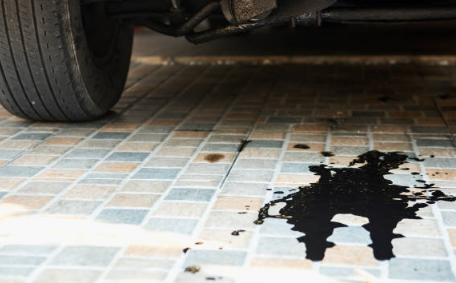It was a wonderful morning. You wake up early, have breakfast, and get to work on time – but when you pull the car out, you notice new oil stains on the driveway. Although it’s easy to think that an oil spill is an aesthetic inconvenience, you have to do it not. Cars need oil to run properly, so if you’ve lost your oil, read on to learn about the most common causes of oil leaks and what to do if you have oil.

Why Is My Car Leaking When Parked?
If you’ve ever owned an oil-burning car, you know that oil loss can be a sneaky, unseen beast. But sometimes, oil spills aren’t so sneaky and instead choose to appear in the driveway in the form of unsightly dark stains. Before degreasing and high-pressure washing away stains, check out these four components – one of which could be the culprit causing driveway discoloration and car greasy.
1. Defective Gaskets or Seals
Worn gaskets and seals can be the most common cause of oil leaks, as they are subjected to extremely high heat and pressure every time you drive. Some seals, such as those on timing chain covers, can be difficult to access and are best diagnosed and serviced by a trained professional. Luckily, a critical seal like this one is designed to extend the life of the engine (as long as it’s properly maintained), so it’s likely to be one of these three gaskets:
- Oil pan gasket to seal the oil pan to the bottom of the crankcase.
- An oil pan drain plug that drains oil out of the oil pan. Loose oil pan drain plugs can cause leaks. In addition, the oil pan drain plug has its own gasket that can fail, cause leaks, or accidentally fall off.
- Valve chamber cover gaskets that seal the valve chamber cover to the engine head. This type of gasket is located in the engine compartment (for most vehicles), near the top of the engine. A leaking bonnet may be accompanied by a burnt oil smell as oil may drip onto the exhaust manifold from this location.
2. The Fuel Filler Cap Is Damaged
The fuel filler cap is usually located on the top or side of the engine, and damaged threads or O-rings can also be the source of the oil leak. If your oil filler cap is faulty, you may notice greasy belts and other parts in the engine compartment.
3. Damage to the Oil Pan or Oil Filter
If your vehicle is driving closer to the ground, a damaged oil pan or oil filter could be the culprit, especially if you’ve recently scraped the underside of your car on unexpected speed bumps, sidewalks, or other obstacles. When the oil pan is damaged, it can cause the aluminum pan to crack or the steel pan to perforate. Both of these conditions can result in a considerable amount of oil leakage. However, if you notice a large amount of oil underneath your vehicle, your oil pan or oil filter may have been punctured or cracked.

4. Poor Rear Main Seal
If everything else is checked correctly, the leak may be due to one of those critical seals we mentioned earlier. The rear main seal is responsible for preventing oil from leaking from the rear of the engine mated to the gearbox.
Depending on the potential severity of the rear main seal failure, you may notice small drips of water when the car is turned off, and larger puddles when parked but still driving. This is because the oil level is usually lower than the rear main seal when the vehicle is turned off. However, while running, the oil circulates throughout the engine – a hot, pressurized environment.
Now that the viscosity is reduced and thrown in all directions, your oil can slide through the rear main seal and into the bell casing of the transmission. Once the vehicle is turned off, the oil drains back into the sump and stops draining through the rear main seal, but the oil that has built up in the transmission housing continues to drip out when stopped.
So, if you mainly notice that your car is leaking oil while parking and driving, it could be due to worn rear main seals. Although it may be tempting to fill up the oil and keep driving, faulty rear main seals should be replaced as soon as possible, as they can fail and leak quickly.
In general, the gearbox must be removed from the vehicle where the rear main seal needs to be replaced, so this repair is absolutely best carried out by a professional.